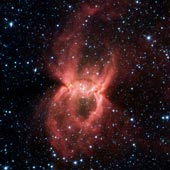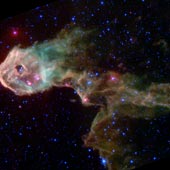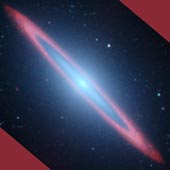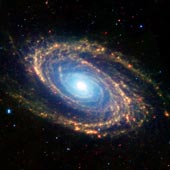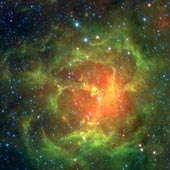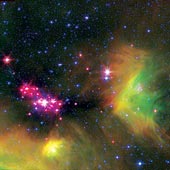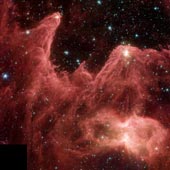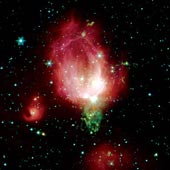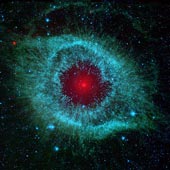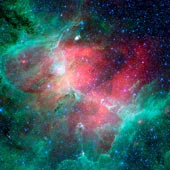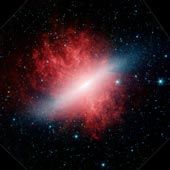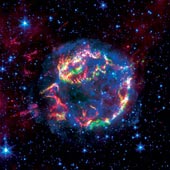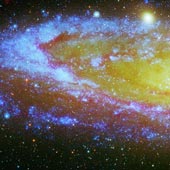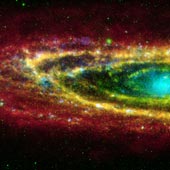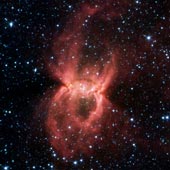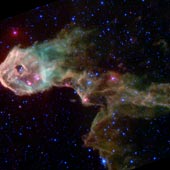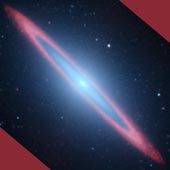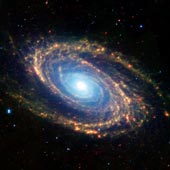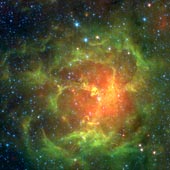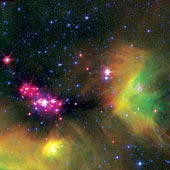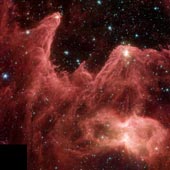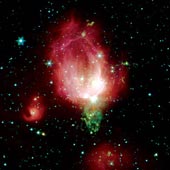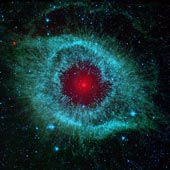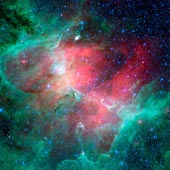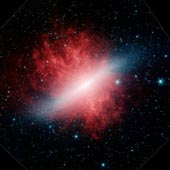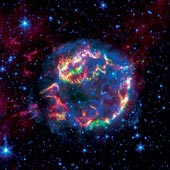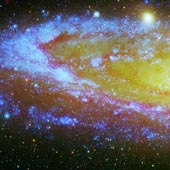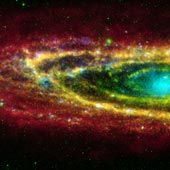A B C D E F G H I J K L M N O P Q R S T U V W X Y Z
- A
- Andromeda Galaxy
- The closest major galaxy to our own Milky Way. It is 2.5 million light-years away. Like our Milky Way, Andromeda is a large, spiral galaxy.
- asteroid
- Rocky objects that are part of the solar system. They are too small to be dwarf planets. They vary in size from 10 meters (33 feet) to a few hundred kilometers (100 kilometers is 60 miles). Most asteroids are found in the asteroid belt, which lies between the orbits of Mars and Jupiter.
- arms
- In astronomy, the long, glowing streamers of stars, gas, and dust that swirl around a spiral galaxy.
- astronauts
- Humans who travel in space.
- astronomy
- The study of matter in outer space, such as planets, stars, and galaxies. Astronomy also includes the study of energy (light) from objects in space and from the formation of the universe.
- atom
- The smallest particle of any element that still looks and acts like that element.
- aurora
- Colorful curtains of moving light in the night sky caused by charged particles from the Sun interacting with Earth's atmosphere near the North and South Poles.
- axis
- The imaginary line through the middle of a rotating object around which the object spins.
- B
- Big Bang
- The name scientists give to the events that started the universe.
- Big Dipper
- A constellation shaped like a soup ladle or dipper. A constellation is a pattern of stars that humans think look like some familiar shape. See Ursa Major.
- binary star
- Actually means two close stars that are orbiting each other.
- black dwarf
- A star thought to be created when a white dwarf (which is what is left after some stars die) cools enough to no longer emit significant heat or light. None have ever been detected.
- black hole
- A region of space containing so much matter in such a small space that its enormous gravity will not allow even light to escape. So it may look like a hole, but it's anything but empty.
- brown dwarf
- A large body that is too big to be a planet but too small to ignite nuclear fusion and become a full-fledged star. Nuclear fusion occurs in a star when the pressure from gravitational forces is so great that atoms combine to become a different atoms, releasing a huge amount of energy in the process.
- C
- carbon
- A very common element in the universe. It is the basic chemical building block of life as we know it.
- celestial
- Having to do with the sky, space and astronomy.
- chromosphere
- A layer of the Sun's atmosphere, just above the photosphere. It is about the depth of Earth's diameter.
- cloud
- In space, a cloud means a region of gases, either left over from an exploding star (a supernova) or from some other source.
- cold
- Not putting out very much infrared radiation, or heat. Many objects in the universe are cold and can only be seen by a telescope such as Spitzer that is also very cold and can detect small levels of infrared radiation.
- comet
- A small, icy, rocky chunk of material in orbit around the Sun. Comets are thought to contain old, leftover material from when our solar system formed.
- constellation
- A pattern of stars in the sky that humans think look like some familiar shape. Although the stars may look like a group to us, they may be very, very far apart.
- Crab Nebula
- A beautiful cloud of glowing gas and dust left over from a supernova explosion.
- D
- dust
- Small particles of matter. Dust floating in space may hide views of stars and planets from ordinary telescopes. The Spitzer Space Telescope can "see" right through dust.
- E
- Earth
- Our home planet, third from the Sun. Earth is farther from the Sun than Venus and closer to the Sun than Mars.
- electromagnetic
- Electromagnetic energy is light energy. But only a small part of it is visible light. This energy travels in waves. Shorter waves, such as ultra-violet and x-rays, carry more energy than longer waves, such as infrared and radio waves.
- element
- A substance that contains only one kind of atom. For example, oxygen and carbon are elements. Elements combine with each other to make compounds. For example, oxygen and carbon can combine to form carbon dioxide, which is very different from either oxygen or carbon.
- elliptical galaxy
- A galaxy that is shaped like an ellipse, an elongated circle, without any spiral arms.
- energy
- Energy is the ability to do work. It comes in many forms, like light, heat, electricity, gravity, nuclear, etc. Energy can be stored, as in your food. One kind of energy can be changed into another kind, as when electrical energy turns into light and heat in a light bulb.
- F
- force
- A pull or a push that causes an object to speed up or slow down in a particular direction.
- frequency
- Another way to describe the wavelength of light (or electromagnetic) energy. Frequency is the time it takes for one whole wave of energy to pass a certain point. The higher (faster) the frequency, the shorter the wavelength, and the more energy carried in the wave.
- fusion
- The process in which two atoms join together to make a different atom, usually releasing a huge amount of energy in the process. In stars, fusion is happening, with hydrogen atoms combining to form helium and other heavier elements. Fusion is what makes stars shine.
- G
- galactic
- Having to do with galaxies.
- galactic center
- The dense, bright center of a galaxy. there is a supermassive black hole at the center of our own Milky Way galaxy, and likely at the center of most other galaxies.
- galaxy
- A grouping of stars, planets, moons, gas, dust, and other objects that are bound together by gravity. Almost all stars reside in galaxies.
- gamma rays
- A very high-frequency, high-energy form of light (or electromagnetic) energy. Even more energetic than x-rays.
- gas
- A state of matter without a definite shape or size, with the molecules (smallest particles of the gas) in nearly random motion. Air is a gas.
- gravity
- A force that causes all matter to be attracted to all other matter.
- H
- heat
- A form of energy that can be transferred from one place or object to another when there is a difference in temperature.
- heliocentric
- Having an orbit with the Sun at the center. The planets of the solar system, including Earth, have heliocentric orbits. The Spitzer Space Telescope has a heliocentric orbit too, trailing behind Earth.
- heliopause
- The boundary where the Sun's solar wind meets the interstellar medium, which is the combined winds from the surrounding stars. We don't know exactly how far away it is.
- heliosphere
- The "bubble" blown into space by our own Sun's solar wind. The entire solar system in inside the heliosphere.
- hydrocarbon
- A material that is made up of hydrogen and carbon. Gasoline is a hydrocarbon. The gunk left in a car's exhaust pipe is a hydrocarbon. Clouds of some types of hydrocarbons are commonly seen floating in space.
- hydrogen
- The lightest and most common element in the universe.
- I
- image
- A likeness of a thing or a place. Telescopes such as the Spitzer Space Telescope can make images of far-away objects in space using light that humans cannot even see.
- infrared
- A kind of light energy we cannot see but can feel as heat. Its range of wavelengths is just a little longer than the wavelength of red light and shorter than microwave radiation.
- interstellar
- The space between the stars and their solar systems, if they have them.
- J
- Jupiter
- The largest planet in our solar system. Jupiter is a gas giant, the fifth farthest planet from the Sun. Over 1000 Earths would fit inside Jupiter.
- K
- L
- life
- A condition of matter that makes it able to take in food and convert it to energy, grow, and make copies of itself. Life has been found to thrive in many kinds of harsh environments on Earth.
- light
- A kind of energy, also called electromagnetic energy. The light we see is just a very small part of all the kinds of light.
- light-year
- The distance that light can travel in one year. Light travels at the cosmic speed limit, 186,000 miles per second!
- Little Dipper
- A constellation of stars that resembles a soup ladle or dipper. It is smaller than the Big Dipper constellation. See Ursa Minor.
- local group
- A group of over 35 galaxies that includes our own Milky Way Galaxy. The local group covers a diameter of about 10 million light-years. The Milky Way and the Andromeda Galaxy are the two largest in the group.
- luminosity
- The amount of energy (or light) an object radiates (sends out) in a given period of time.
- M
- magnetosphere
- The magnetic field that surrounds Earth or any magnetized planet. Earth's magnetosphere protects Earth's surface from harsh radiation from the Sun that would make life impossible.
- magnitude
- Referring to a star or planet in the night sky, it is the brightness of the object as seen from Earth. Astronomers have precise ways to categorize the magnitude of a planet, star, or galaxy.
- Mars
- The fourth farthest planet from the Sun. It is about one-fourth the size of Earth.
- mass
- The amount of matter in an object. Different from weight. Weight is the force of gravity acting on mass.
- matter
- Anything that has mass and takes up space. It is the substance that makes up physical objects.
- Mercury
- Planet closest to the Sun in our solar system.
- meteor
- Also called a "shooting star," when a small piece of space debris enters Earth's atmosphere and burns up from the friction with the air molecules.
- Milky Way
- Our own spiral galaxy. On a clear, dark night, we can see our own galaxy as a bright "milky" streak across the sky.
- molecule
- Atoms (the smallest particles of elements) bonded together to make a different substance (a compound).
- moon
- A natural object that orbits a planet. Earth has one moon called "Moon."
- N
- NASA
- National Aeronautics and Space Administration, the U.S. government agency in charge of exploring space.
- nebula
- A cloud of gas and dust in space. May be the leftovers of a supernova, the explosion at the end of a massive star's life.
- Neptune
- The eighth, and farthest, planet from the Sun.
- neutron star
- A very dense object that is left over from the violent supernova death of a massive star. It spins very rapidly.
- North Star
- If you are standing at the North Pole, this is the star that will be directly overhead. This star is currently Polaris.
- O
- observatory
- A place or an instrument for observing objects and events in space. An observatory may be on the ground or in space, such at the Spitzer Space Telescope or the Hubble Space Telescope.
- orbit
- The path of one object around another more massive object, defined by gravitational forces between the two objects.
- Orion
- A constellation named for Orion the Hunter in Greek mythology. The Orion Nebula is located in the Orion constellation near the "belt" of the hunter. This nebula is a giant star nursery where new stars are forming on a very grand scale.
- oxygen
- An element that is very abundant throughout the universe. Earth's atmosphere is about 20% oxygen. All animal life on Earth must breathe oxygen to survive.
- P
- parallax
- The apparent shift of an object against its background when viewed from different locations. Scientists can measure the distance to some stars by observing the shift in a star's apparent position as Earth travels around the Sun.
- photometer
- An instrument for detecting and measuring light. The Spitzer Space Telescope has a very sensitive instrument called the Multiband Imaging Photometer.
- photosphere
- The visible outer layer of the Sun.
- planet
- An object in orbit around the Sun (or another star) that is large enough for gravity to have pulled it into a nearly spherical (round) shape, and that has cleared (by gravitational attraction) the dust and debris out of the neighborhood of its orbit.
- Polaris
- The star that is now in the right position to be the North Star, the one positioned almost directly above Earth's North Pole.
- protostars
- Large objects that are becoming stars. They are not yet quite large enough or dense enough to produce nuclear fusion and become stars.
- pulsar
- A rotating neutron star that emits a beam of radiation, like a lighthouse beacon. A neutron star is the very dense object that can remain after a very massive star explodes in a supernova at the end of its life.
- Q
- quasar
- A very distant, powerful object. Quasars are believed to be areas of very compact matter surrounding a supermassive black hole in the center of a galaxy.
- R
- radiation
- Energy in the form of waves, such as visible light, infrared light, or radio waves.
- radio waves
- A kind of electromagnetic energy (light) with wavelengths anywhere from a few centimeters (a centimeter is about one-half inch) to several kilometers (or miles) long. Radio waves are often used to carry signals to and from spacecraft and Earth.
- ray
- A beam of light. Can be of any or all wavelengths, visible and invisible, such as an x-ray or a ray of sunlight.
- red giant
- A stage near the end of a medium-sized star's life. The star becomes much larger and cooler, thus glowing in red instead of white or yellow. Our own Sun will become a red giant in about 5 billion years.
- reflection
- The change in direction of light waves or sound waves as they bounce off a surface.
- rocket
- A vehicle that burns fuel and shoots the flaming gases out one end (the engine) to move in the opposite direction. The force produced is called thrust.
- rotate
- To spin, as the Earth spins on its axis or a skater spins on the ice. Do not confuse with "revolve" or "orbit," both of which mean one object moves around another, larger object.
- S
- satellite
- Any object that orbits another, larger object. There are natural satellites, such as the Moon, and artificial satellites, such as communication and weather satellites that are put into orbit around Earth by people.
- Saturn
- The sixth farthest planet from the Sun. It is a gas giant, the second largest planet (after Jupiter) in our solar system. Saturn has a large, complex set of rings.
- shine
- To give off light. May be visible light, ultraviolet, infrared, or any and all wavelengths.
- solar system
- A system of planets, moons, asteroids, comets, dust, gas, and any other objects that orbit a star, tied to it by the star's gravitational force.
- space
- The container without walls of all matter and energy.
- Space Shuttle
- A reusable vehicle that carries humans and cargo to low Earth orbit. It is launched by a rocket and returns to Earth like a glider, landing on an airstrip.
- spectrograph
- An instrument that separates light into its different wavelengths (or colors) and looks at the wavelength "fingerprints" to find out what substance emitted the light or what substance (gas) the light has passed through.
- spectrum
- The different wavelengths contained in light all separated from one another. A rainbow is a spectrum. Instruments such as spectrographs separate light energy into a spectrum. The spectrum reveals what substance emitted the light or what substance the light has passed through.
- spiral arms
- The long, curving "streamers" of stars, gas, and dust that can be seen in a spiral galaxy.
- star
- A huge, dense ball of gas that generates nuclear fusion, thereby releasing huge amount of energy. The gas is so dense because gravity has squished all the gas into the smallest possible space. When gravity presses hard enough, the atoms combine to make different atoms, releasing huge amounts of energy, like a nuclear bomb. The star is a balancing act between the inward pull of gravity and the outward push of the nuclear energy. Our Sun is an average-size, middle-age star.
- starlight
- The light that is emitted from stars, most of which is beyond the small range of wavelengths (or colors) our eyes can detect. The light from a star can tell a scientist the star's temperature, age, size, and other information.
- stellar
- Anything having to do with stars.
- Sun
- Our star, the center of our solar system. The Sun is a middle-aged, ordinary star.
- sunspot
- An area on the Sun's surface that is cooler than its surroundings and has intense magnetic activity.
- supergiant
- The most massive stars, 10 to 70 times more massive than our Sun.
- supernova
- The brilliant explosion of a massive star at the end of its life. A supernova happens in about 15 seconds and shines with the light of an entire galaxy. Only 2 or 3 supernovas happen in our galaxy in a century.
- T
- telescope
- An instrument for seeing faint and distant objects more clearly. A telescope may also be designed to see wavelengths of light (or colors) that are either longer or shorter than the range our eyes can see.
- temperature
- A measure of how hot or cold an object or substance is. It is a measure of the heat energy contained in the object or substance.
- theory
- An explanation of a natural occurrence that is testable and capable of predicting future occurrences.
- transparent
- Allowing light to pass through. Although often gas and dust clouds in space are not transparent to visible light, they are transparent to infrared light, thus allowing Spitzer space Telescope to see through them to what is inside them (such as newly forming stars).
- U
- ultraviolet
- The "color" of light that has a wavelength a bit shorter than the shortest wavelength of light (blue or violet) that our eyes can see, but wavelength longer than x-rays.
- universe
- Everything that exists. All of space, time, matter and energy, and all the laws that govern their behavior.
- Ursa Major
- The constellation, or pattern, of stars that was thought by the ancient Romans to resemble a great bear. The seven stars in the bear's hindquarters and tail form what we know as the Big Dipper.
- Ursa Minor
- The constellation, or pattern, of stars that the ancient Romans thought resembled a little bear. It is also known as the Little Dipper. The star at the end of the dipper "handle" is Polaris, the North Star.
- V
- Venus
- The second farthest planet from the Sun. Venus is covered in a thick atmosphere of carbon dioxide, making the planet's surface hot enough to melt lead.
- visible light
- The range of wavelengths, or colors, of light that we can see with our human eyes.
- W
- water
- The chemical substance that covers nearly three-fourths of Earth's surface. It is necessary to life as we know it.
- wavelength
- Light energy travels in waves, or pulses. A wavelength is the distance from the top, or crest, of one wave to the crest of the next wave. The longer the wavelength, the less energy the light has.
- waves
- The "up and down" form in which energy travels. Waves in the ocean are caused by energy moving through the water. Sound waves are energy moving through the air. Light waves are electromagnetic energy moving through space, air, or other substances.
- Whirlpool Galaxy
- A beautiful spiral galaxy, about 30 million light-years away. Because it is "face on" when seen from Earth, we can clearly see its spiral structure.
- white dwarf
- The small, weakly glowing object left at the end of some stars' lives, after they've blown off most of their material. Our own Sun will end as a white dwarf—in about 5 billion years.
- X
- x-rays
- A very high-energy (short wavelength) form of electromagnetic radiation, also know as light. X-rays are invisible to us, but can easily penetrate our bodies.
- Y
- Z



